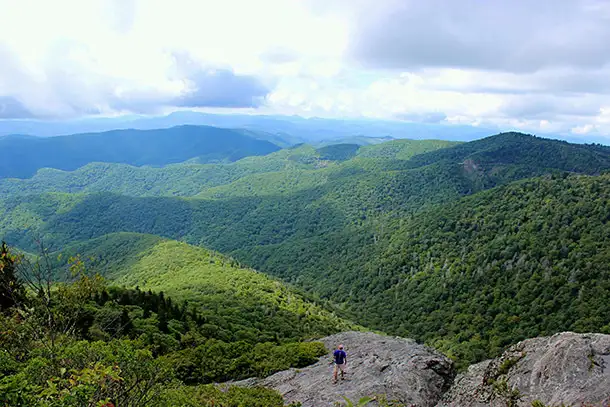
It’s time to celebrate! This year marks the 100th anniversary of the National Parks Service, and we’re honoring the centennial by featuring one great park perfect for every month. As a bonus, we’ll also give you the scoop on a less-known park that’s perfectly in-season.
Why Great Smoky Mountains National Park Is Amazing
By far the most popular national park in the United States, Great Smoky Mountains National Park’s 10.5 million annual visitors double what runner-up Grand Canyon sees. Yet despite the millions of visitors who drive through it each year, usually on the scenic Blue Ridge Parkway, the park manages to preserve a piece of Southern Appalachia that hardly exists anymore.
Its dense, old-growth deciduous forests are home to 130 native tree species, as many as on the entire European continent. This rich woodland is considered so important that UNESCO has named the park both a World Heritage Site and an International Biosphere Reserve. The trees are also responsible for the phenomenon that gives these mountains their name—their leaves exhale volatile hydrocarbons that form a smoke-like haze that hovers over the range.
The 800-square-mile park, which straddles the border between North Carolina and Tennessee, also preserves more than 90 log buildings, including churches, barns, schools, and grist mills, offering a glimpse into Appalachian life more than 100 years ago when small communities called these valleys home. Cades Cove is the most popular destination in Great Smoky Mountains National Park, a broad pastoral valley encircled by an 11-mile driving loop where sightings of white-tail deer are common, and, occasionally, coyote, turkey, and even black bear.
Why April Is the Perfect Time to Go
Great Smoky Mountains National Park isn’t just famous for its trees. “Wildflower National Park,” as it’s sometimes called, is prized for the breadth of its wildflower diversity: More than 1,500 species of flowering plants are found in the park, the most of any national park in North America.
Lady slipper orchids, jack-in-the-pulpit, columbine, crested dwarf iris, 10 species of trillium, bleeding heart, and violets—just to name a few—are celebrated every April at the park’s five-day “Spring Wildflower Pilgrimage.” This year’s event (April 19-23) will feature guided programs, walks, photographic tours, art classes, and more.
Why It’s Great at Other Times of Year
Each season yields its own reasons for visiting the park. In the fall, the hills thrill leaf-peepers who come by the tens of thousands to see the hillsides ablaze with autumn color; by winter, the deciduous leaves have dropped, allowing motorists to see vistas not visible at other times of the year. In summer, hikers can take to the lush forests to cool off in refreshing waterfalls and streams. And in late spring, nature puts on yet another fantastic show: the bioluminescent spectacle known as the mating ritual of the synchronous fireflies, one of the 19 species of lightning bugs in the park, and the only species capable of synchronizing their light patterns. For the duration of the firefly mating season, the park runs shuttles from the Suglarlands Visitor Center to the Elkmont viewing area. (Once the dates are announced in mid-late April, the shuttles fill up almost immediately, so check this site frequently if you’re interested.)
If You Go, Don’t Miss
The huge majority of people who visit do so by driving through; but it’s really worth the time to get out of the car and off the beaten path into the woods. You don’t need to backpack the Appalachian Trail or even anything close: Scattered throughout the roads in park, including five on the Newfound Gap Road, are numerous small turnouts (big enough for one or two cars) that lead to “quiet walkways.”
These are nothing more than easy, accessible paths (marked by signs) that coax visitors into the stillness of the forest, to take as little or as much time as they’d like to walk or sit on a rock, and breathe in the mountain air. (Another not-to-miss: the elk that gather in Cataloochee Valley, an easy drive from Asheville, North Carolina. The elk, re-introduced in 2001, are best seen when they gather near the road around dawn and again at sunset.)
April Bonus Pick: Pinnacles
April is prime time for Pinnacles, on the eastern edge California’s Salinas Valley. The wildflowers are typically at their peak and the temperatures have not yet started their climb into the occasional triple digits of summer. Our newest national park (inducted in January 2013) is popular with rock climbers and hikers, but probably most famous for its population of California condors, which were nearly extinct 25 years ago. Thanks to a captive breeding program, the magnificent condor—whose wingspan reaches nearly 10 feet—now number more than 400 in the entire world, 32 of which are free-flying at Pinnacles.
More from SmarterTravel:
- Everglades: Our January National Park of the Month
- Death Valley: Our February National Park of the Month
- Hot Springs: Our March National Park of the Month
Deb Hopewell is a longtime journalist and the former editor of Yahoo Travel. She writes for Outside, Fodor’s, Architectural Digest, Travel+Leisure, Yahoo Travel, and others. Follow her on Instagram @debhopewell and Twitter @dhopewell.
We hand-pick everything we recommend and select items through testing and reviews. Some products are sent to us free of charge with no incentive to offer a favorable review. We offer our unbiased opinions and do not accept compensation to review products. All items are in stock and prices are accurate at the time of publication. If you buy something through our links, we may earn a commission.
Related
Top Fares From
Today's Top Travel Deals
Brought to you by ShermansTravel
Australia: Upscale, 8-Night Cairns, the Gold...
Down Under Answers
 vacation
$3899+
vacation
$3899+
Greenland: Luxe, All-Incl. 11-Nt Exploration Small-Ship...
Swan Hellenic
 cruise
$3289+
cruise
$3289+
Ohio: Daily Car Rentals from Cincinnati
85OFF.com
 Car Rental
$19+
Car Rental
$19+



